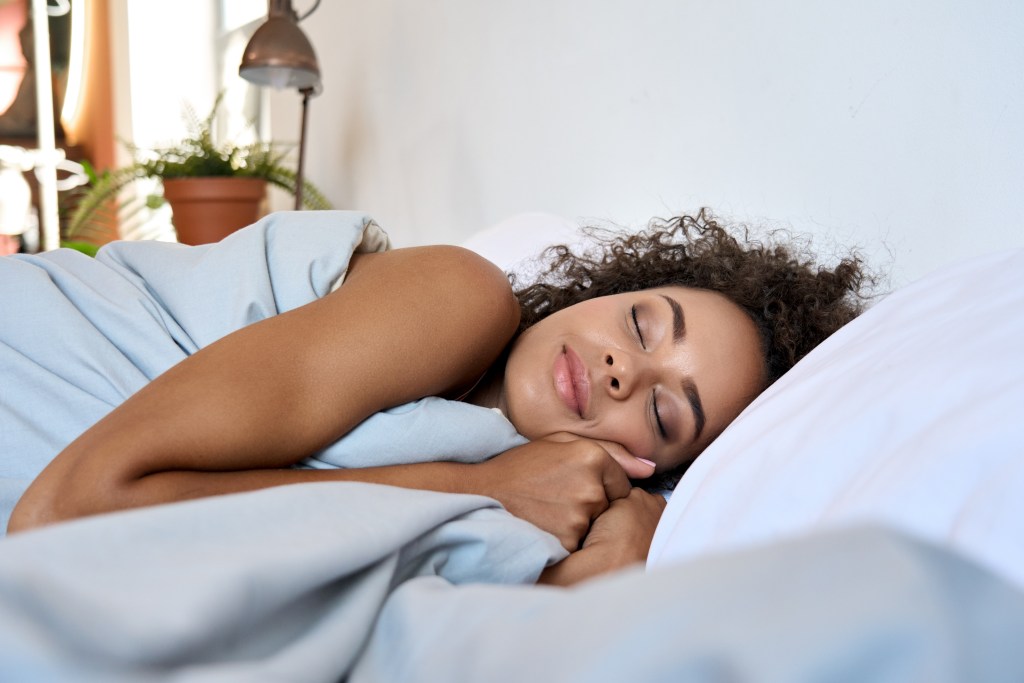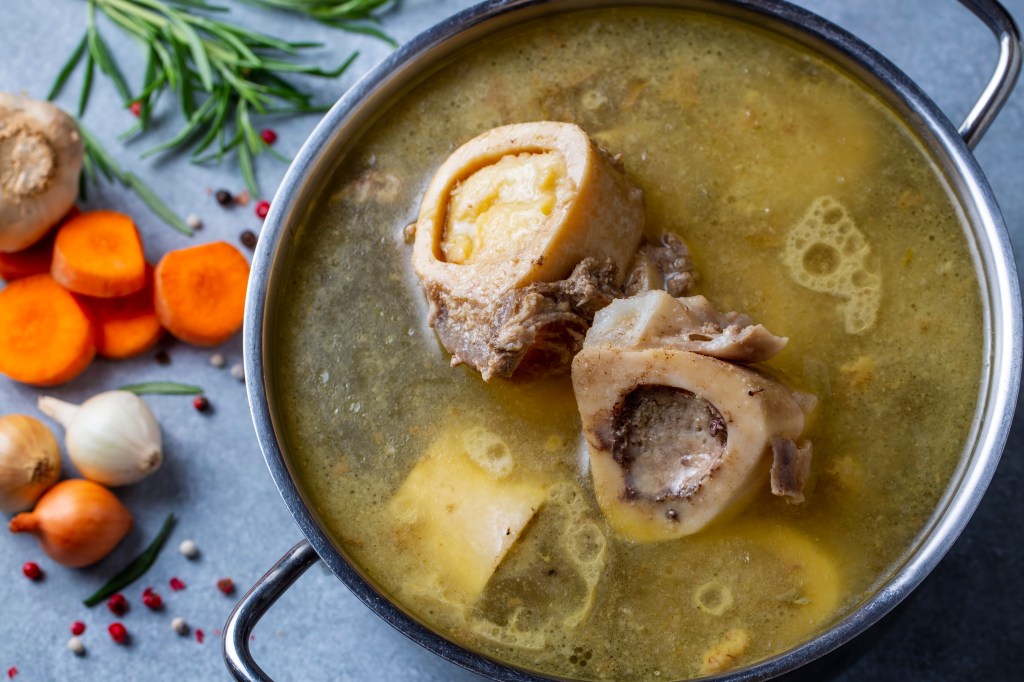Bone broth is considered one of humankind’s earliest health foods, with evidence of its use dating back to the hunter-gatherers.
Recently, bone broth benefits, such as its ability to support joint health and overall vitality, have been in the scientific spotlight, mainly due to a growing interest in natural and holistic nutrition.
Discover the numerous health advantages of bone broth and learn how to make it from scratch.
What is bone broth?
Bone broth is a nutrient-rich liquid made by boiling animal bones, meat, and connective tissue at low temperatures for prolonged times. It can be made from any animal, such as chicken, beef, pork, or fish, and often includes seasonings and vegetables for added flavor.
Simmering animal bones releases essential nutrients, including proteins and minerals.
Notably, it breaks down the connective and bone tissues, which releases collagen. This crucial nutrient is composed of several amino acids and is a vital component for hair, skin, and nail health.
The end product is a healthful and restorative soup that can be enjoyed on its own or added to other recipes, such as stews and sauces.
Is bone broth good for you? Watch this video to learn more!
Bone broth nutrition
While they can be made from just about any animal, bone broths made from chicken and beef bones are among the most common options. Other types, including turkey bone broth and pork bone broth, are also becoming increasingly popular choices.
However, since there are many ways to make bone broth, the nutritional value can vary depending on the specific recipe and cooking time.
Here is the average nutritional information for one cup (237 milliliters) of chicken bone broth:
- 40 calories
- 1 g fat
- 9.5 g protein
- 0 g carbohydrates
In addition, bone broth is a rich source of various essential nutrients, including:
- Calcium
- Potassium
- Sodium
- Collagen
- Amino Acids
6 benefits of bone broth
Incorporating bone broth into your diet is a simple and effective way to support overall health and well-being.
Here are six benefits of bone broth.
1. Improves bone and joint health
Research published in Nutrients highlights the significant role of collagen in bone and joint tissue regeneration.1
The study suggests that collagen, particularly hydrolyzed collagen, supports the repair and regeneration of cartilage. This can contribute to skeletal health and functionality, which may help support joint comfort and mobility in individuals experiencing age-related cartilage wear.
In addition to collagen, bone broth also contains glucosamine, another beneficial compound promoting the structural integrity and function of cartilage.
2. Supports a healthy gut
Bone broth contains gelatin, a protein structure that can help maintain and repair the cells that line the gut. This supports a favorable environment for gut bacteria linked to a diverse intestinal microflora.
This nourishing broth is also a rich natural source of glutamine, an amino acid that plays a crucial role in maintaining the health of the intestinal wall and enhancing the absorption of nutrients.
Dr. Berg explains, “Glutamine has been shown to improve gut barrier function. A healthy gut barrier is vital for preventing leaky gut syndrome, where unwanted substances can leak through the intestinal walls and cause chronic inflammation or other health issues.”

3. Improves sleep quality and neurological health
Bone broth contains the amino acid glycine, which has been shown to promote relaxation, enhance sleep, and support the nervous system.
Research published in GeroScience suggests that, when included as part of a nutrient-rich diet, glycine may promote restful sleep and mental clarity, especially when consumed 30 minutes to 1 hour before bedtime.2
Glycine also stimulates the production of serotonin, a neurotransmitter that regulates mood and promotes feelings of well-being.
According to evidence published in Frontiers in Aging Neuroscience, increased blood serotonin levels were linked to a lower risk of neurodegenerative diseases such as Alzheimer’s.3
4. Weight management
Research published in Nutrients highlights that glutamine may support insulin sensitivity and help lower inflammation, which is vital for preventing weight gain.4
Chronic inflammation can impair insulin signaling, increasing the risk of insulin resistance, the leading cause of metabolic syndrome and diabetes.
When cells become resistant to insulin, the body’s ability to regulate blood sugar balance is diminished. This can lead to chronically elevated blood glucose levels, which trigger fat storage and food cravings.
Consuming glutamine-rich foods such as bone broth may help restore normal insulin function and improve appetite regulation and energy utilization, thereby supporting weight loss and weight management.

5. Anti-aging effects
A study published in Dermatology Practical & Conceptual suggests that collagen may help support skin hydration, elasticity, and the appearance of fine lines.5
Collagen also promotes the body’s natural production of other anti-aging agents, such as elastin and hyaluronic acid, which may enhance skin integrity and help slow the aging process.
This indicates that consuming collagen-rich foods, including bone broth, may be a simple and effective way to help maintain skin integrity.
6. Detoxification
Glycine is a precursor to glutathione, a powerful detoxifying antioxidant that helps neutralize toxins and other harmful compounds in the body.
“Glutathione is one of the most important antioxidants of all. Without it, your body can’t effectively detoxify, which can lead to a buildup of toxins in the body,” says Dr. Berg.

Can you have bone broth while fasting?
While many people believe that bone broth is acceptable while fasting, it’s important to note that it does contain significant amounts of calories and protein, which can break a fast.
Dr. Berg explains, “Protein stimulates insulin production, which is why consuming things like collagen or bone broth can interfere with ketosis and break a fast.”
To reap the full benefits of fasting, opt for zero-sugar and calorie-free beverages such as water, black coffee, or herbal tea during your fasting periods.

How to make bone broth
Making homemade bone broth is a simple process with much room for experimentation.
To prepare your own bone broth, the most important thing is to consider the quality of the ingredients.
Ideally, start with bones from pasture-raised livestock, as these animals tend to be healthier and offer the most nutritional value.
In addition, joint bones and bones with thick marrow sections, typically contain the most collagen, which breaks down into gelatin during prolonged simmering.
Gelatin not only gives the broth a full-bodied taste but also provides health benefits such as supporting joint health and digestive function.
When it comes to produce, prioritize organic and non-GMO certified to ensure the highest nutrient content and protect your broth from soaking up potentially harmful pesticides.

Easy Homemade Bone Broth
This easy bone broth recipe explains step-by-step how to make your bone broth using just a few common kitchen ingredients.
This recipe yields approximately 16 servings, depending on how much liquid evaporates during the simmering process.
Time: 24 hours
Servings: 16
Per serving: 50 calories, 9 g protein, 0 g carbohydrates, 2 g fat
Ingredients
- 3 pounds bones
- 2 tablespoons apple cider vinegar
- 2 gallons water
- Himalayan pink salt or sea salt to taste
Optional ingredients
- 1 onion, quartered
- 2 large carrots, roughly chopped
- 4 celery stalks, roughly chopped
- 2 cloves garlic, smashed
Optional seasonings
- 2 bay leaves
- 1 bunch parsley stems
- 1 sprig fresh thyme
- 1 sprig fresh rosemary
- 1 teaspoon dried sage
- 1 teaspoon dried oregano
- 1 2-inch piece ginger, sliced
- Freshly ground black pepper to taste
Directions:
1. Place bones in a large stockpot.
2. Add apple cider vinegar and water to pot.
3. Let sit for 30 minutes to allow acid to initiate breakdown of minerals in bone tissue.
5. If desired, add optional ingredients to pot.
6. Bring mixture to a boil over high heat, then reduce to low and simmer for up to 24 hours. The longer the broth simmers, the more nutrient-dense the broth.
7. Remove from heat and allow broth to cool.
8. Strain broth through mesh strainer or cheesecloth into a large bowl or container, separating solids from liquid broth.
9. Season with sea salt and fresh ground pepper to taste, and enjoy!
After the bone broth has cooled to room temperature, it can be stored in a glass jar in the refrigerator for up to five days or in the freezer for up to six months.

Key takeaways
Bone broth consists primarily of water, bones, connective tissues, and occasionally flavor-enhancing vegetables and herbs.
Bone broth is a rich natural food source of collagen, amino acids, minerals, and other beneficial nutrients linked to various health advantages.
Bone broth benefits include supporting gut health, joint function, and sleep quality while aiding in weight management and providing potential anti-aging effects.
FAQ
1. What are the top bone broth benefits?
The top benefits of bone broth include supporting gut, bone, and joint health while promoting detoxification, healthy weight management, skin elasticity, and hydration.
2. Is bone broth keto-friendly?
Yes, bone broth is keto-friendly, as it’s low in calories and contains almost no carbohydrates.
Drinking bone broth on a keto diet can be an excellent way to obtain essential nutrients and improve satiation, which can aid weight loss and promote a healthy body.
3. Can I have bone broth while fasting?
No, you shouldn’t drink bone broth while fasting, as it contains calories and protein, which can break a fast.
4. What happens if you drink bone broth every day?
Consuming bone broth regularly can be a valuable part of a balanced diet, contributing an array of vital nutrients for overall health.
Drinking bone broth daily can support healthy digestive function and vitality and promote restful sleep.
5. What does bone broth do for the body?
Bone broth is an excellent source of protein and minerals needed to support gut health, joint function, sleep quality, weight management, and skin health.
6. What are the downsides of bone broth?
Potential downsides of bone broth include high sodium content and the possibility of consuming contaminants if low-quality ingredients are used.
Those with certain health conditions or concerns about sodium should seek guidance from a healthcare professional or registered dietitian before regularly incorporating bone broth into their diet.
7. Does bone broth have any protein?
Bone broth is an excellent source of protein, providing around ten grams per cup (237 milliliters).








